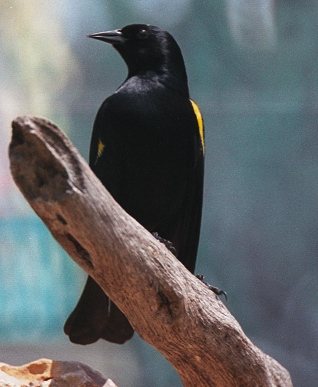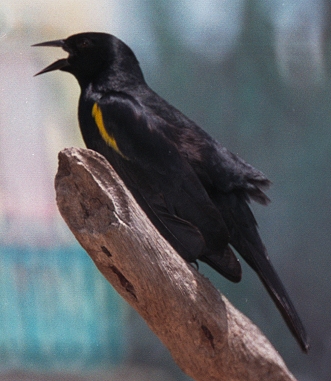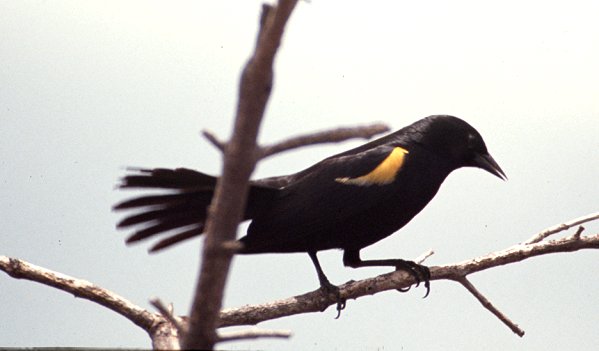|
Yellow-shouldered Blackbird Agelaius xanthomus Mariquita de Puerto Rico,
|
 |
|
Photo: G. Lasley
|
|
Yellow-shouldered Blackbird Agelaius xanthomus Mariquita de Puerto Rico,
|
 |
|
Photo: G. Lasley
|
|
IDENTIFICATION: A medium-sized, black bird with yellow "shoulder" patches, and a pointed bill. Unlike many other blackbird species, the male and female have similar plumages. Length: 20-23 cm.; weight: males 41 g., females 35 g. VOICE: Produces a large variety of nasal call notes and whistles; the call is a low "chick", which it gives while flicking its tail. Audio (M.Oberle). HABITAT: The Yellow-shouldered Blackbird was formerly found in lowlands around Puerto Rico, but is now basically restricted to Mona Island, Roosevelt Roads, and the open, dry forests and mangroves of southwestern Puerto Rico. In the non-breeding season it flocks to fields and livestock corals. HABITS: Feeds mostly on insects in trees. Prey include weevils, other beetles, caterpillars, moths, crickets, earwigs, wasps, flies, spiders, occasional snails and seeds. It sometimes flocks with Greater Antillean Grackles and Shiny Cowbirds, and will fly large distances from roosting or breeding areas to feeding sites. It can be attracted to seed feeders. Pairs are mongogamous and display in the nesting season by wing flapping and raising the wing patches while singing. It nests in colonies and places its cup nest in mangroves, palms, and other trees or in a tree cavity or nest box. On Mona Island, it also uses cliffs for nesting and roosting. The female lays 1-4 greenish or blue eggs with brown spots. She incubates them for 13 days. Both sexes feed the young, which leave the nest 13-16 days after hatching. Young birds follow the adults for several weeks after fledging. STATUS AND CONSERVATION: The Yellow-shouldered Blackbird was common in the early 20th Century, but is now on the federal endangered species list. Since the arrival of the Shiny Cowbird from South America in the mid-20th Century, almost all Blackbirdsí nests were parasitized by this species, except on Mona Island. Cowbird chicks grow faster than Blackbird chicks and out-compete them for food. Blackbirds are only half as likely to fledge young from nests that are parasitized by cowbirds, compared to nests without cowbirds. In addition, nest predation by rats and Pearly-eyed Thrashers is a problem, as is competition with Caribbean Martins for nest boxes and cavities and imported diseases such as avian pox virus. The Blackbirdís estimated population on the main island of Puerto Rico dropped to only 200-300 in the 1970s, but has since climbed back to about 800 thanks to programs to control cowbirds in southwestern Puerto Rico. In one study, 100% of nests in 1975 had cowbird eggs on the main island of Puerto Rico, compared to only 4.8% of 229 active blackbird nests in 1995. Blackbirds readily accept artificial nest boxes. However, cowbird trapping and control will probably have to be continued indefinitely in order to guarantee the survival of the Yellow-shouldered Blackbird. The August 2002 post-nesting census in three key areas of southwestern Puerto Rico had 648 blackbirds. A fluctuating population of about 900 blackbirds survive in the non-threatened subspecies on Mona and Monito Islands. Most Yellow-shouldered Blackbirds on Puerto Rico have been banded with aluminium leg bands (see photo above), and many have colored, plastic bands that identify their birth year. RANGE: Endemic to Puerto Rico, Monito, and Mona Islands. A regular location to find the Yellow-shouldered Blackbird is the grounds of the Parador Villa Parguera in La Parguera, where it perches in the palm trees or eats table scraps on the ground. At dawn and dusk outside the breeding season, small flocks of this species fly past the waterfront at La Parguera and Pitahaya en route between mangrove roosts and feeding grounds. TAXONOMY: PASSERIFORMES; ICTERIDAE. The race on Mona Island (Agelaius xanthomus monensis) has paler wing patches than the race on the main island of Puerto Rico (Agelaius xanthomus xanthomus). Several other Caribbean islands have endemic blackbird species: the Red-shouldered Blackbird of Cuba (Agelaius assimilis), the Tawny-shouldered Blackbird (Agelaius humeralis) of Cuba and western Haiti, and the Jamaican Blackbird (Nesopsar nigerrimus). The Red-shouldered and Yellow-shouldered Blackbirds are thought to have evolved from the Red-winged Blackbird (Agelaius phoeniceus) of North America. |
 |
|
Photo: C. Ruiz
|
 |
|
Photo: M. Oberle
|
 |
|
Photo: M. Oberle
|
 |
|
Photo: M. Oberle
|
 |
|
Photo: M. Oberle
|
 |
|
Photo: E. Ventosa
|
|
References BirdLife International. 2000. Threatened birds of the world. Lynx Edicions and BirdLife International, Barcelona and Cambridge, UK. Collar, N.J., L.P. Gonzaga, N. Krabbe, A. Madronno Nieto, L.G. Naranjo, T.A. Parker III, and D.C Wege. 1992. Threatened birds of the Americas: The ICBP/IUCN red data book, 3rd edition, part 2. Smithsonian Institution Press, Washington, D.C. Hernández-Prieto, E. and M. González. 1992. The Yellow-shouldered Blackbird on Monito Island, Puerto Rico. Ornitología Caribeña 3:54-56. Jaramillo A. and P. Burke. 1999. New World Blackbirds: The Icterids. Princeton Univ Press. Lanyon, S. M. 1992. Interspecific brood parasitism in blackbirds (Icterinae): a phylogenetic perspective. Science 255:77-79. Lanyon, S. M. 1994. Polyphyly of the blackbird genus Agelaius and the importance of assumptions of monophyly in comparative studies. Evolution 48:679-693. McKenzie, P. M. and R. E. Noble. 1989. Notes on a large foraging concentration of the endangered Yellow-shouldered Blackbird (Agelaius xanthomus) in southwestern Puerto Rico. Carib. J. Sci. 25:90-91. Miranda, L. 1995. Depredación de Mariquitas por un Falcón Común. El Pitirre 8(2):2. Miranda-Castro, L. 2000. La introducción de especies exóticas a Puerto Rico: un problema que nos afecta a todos. El Bien-te-veo 3(1):2-4. Orians, G. 1985. Blackbirds of the Americas. Univ. of Washington Press, Seattle, WA. Post, W. 1981. Biology of the Yellow-shouldered Blackbird (Agelaius xanthomus) on a tropical island. Bull. of the Florida State Museum Biol. Sci. 26:125-202. Raffaele, H.A. 1989. A guide to the birds of Puerto Rico and the Virgin Islands. Princeton. Raffaele, H.A. 1989. Una guía a las aves de Puerto Rico y las Islas Vírgenes. Publishing Resources, Inc., Santurce, PR. Raffaele, H.A., J.W. Wiley, O.H. Garrido, A.R. Keith, and J.I. Raffaele. 1998. Guide to the birds of the West Indies. Princeton. Vega Castillo, S. I. 1999. Avistamiento de la Mariquita (Agelaius xanthomus) en Ciales, Puerto Rico. El Bien-te-veo 2(4):2. Ventosa-Febles, E.A. 1997. The Yellow-shouldered Blackbird (Agelaius xanthomus) recovery project in the southwest of Puerto Rico. El Pitirre 10(1):34-35. Ventosa-Febles, E.A., R. Lopez, J. Camacho, and A. Falcon. 1997. Control of the Shiny Cowbird (Molothrus bonariensis): can it improve the reproductive success of rare or endangered species? The case of the Yellow-shouldered Blackbird (Agelaius xanthomus) in Puerto Rico. El Pitirre 10(3):110. Wiley, J.W., W. Post, and A. Cruz. 1991. Conservation of the Yellow-shouldered Blackbird Agelaius xanthomus, an endangered West Indian species. Biological Conservation. 55:119-138. Yellow-shouldered Blackbird, Spanish text Next related species in taxonomic order Previous related species in taxonomic order |